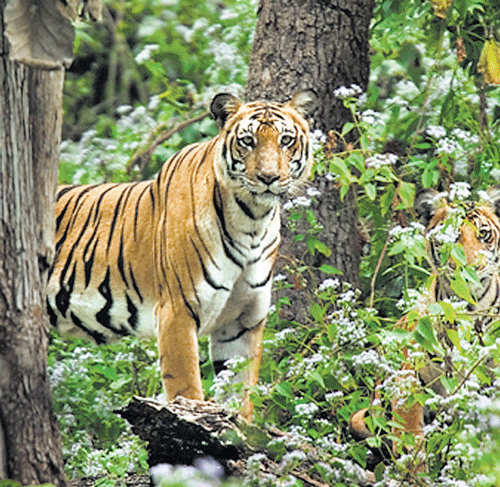
A single ecological continuum spread across three states of India in the biodiversity rich Western Ghats region holds the world's single-largest tiger population, according to a government report.
The latest tiger census report released today said that the states falling in this region witnessed a steady rise in their tiger populations with Karnataka at present leading the big cat count in the country.
"The Mudulalai-Bandipur-Nagarhole-Wayanad complex holds the world's single-largest tiger population currently estimated at over 570 tigers," stated the 2014 tiger assessment report.
The above complex is spread across three states -- Karnataka, Kerala and Tamil Nadu. It is a contiguous zone where there is no perceptible difference in the landscape.
The report said that in the Western Ghat landscape complex, Karnataka has 406 tigers while Kerala and Tamil Nadu have an estimated 136 and 229 tigers, respectively.
Goa which was reported as being without any big cats in the last census was found to be home to five tigers in the latest count.
The report, which was released today by Environment Minister Prakash Javadekar, said that the Western Ghats, including all the four states in total has an estimated 776 tigers (685-861).
All the three states, barring Goa, saw a substantial increase in their tiger populations over the 2010 estimates where the number of tigers were 300, 71 and 163, respectively, in Karnataka, Kerala and Tamil Nadu.
"The report further said that the tiger population and occupancy has shown a substantial increase within this landscape," the report said.
It said that the Sahyadri tiger reserve has between 5-8 tigers based on scat DNA and model-based predictions. The tiger population which is part of Western Ghats landscape is accounted for in the central Indian landscape in Maharashtra.
Second to Karnataka, Uttarakhand has an estimated 340 tigers as against the 227 which were reported in the 2010 assessment. Odisha and Jharkhand have registered a decrease in tiger numbers, respectively, from 32 in 2010 to 28 in 2014 and from 10 in 2010 to 3-plus in the latest report.
As far as other regions are concerned, tiger population in the Sunderbans has remained stable and is estimated to be about 76 (62 to 96) tigers. A major part of the Sunderbans has now been camera-trapped with 62 unique individual tiger photos captured.
The report added said that the big cat population has shown an improvement in Assam where the Kaziranga national park has the maximum number of tigers. Occurrence of tigers in Karbi Hills, Dibang Valley and Namdapha tiger reserve, on the other hand, has been encouraging, it said.